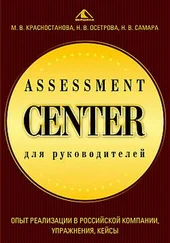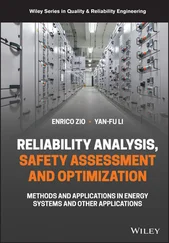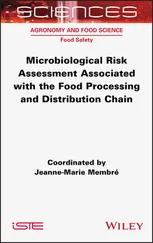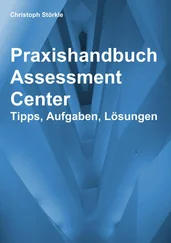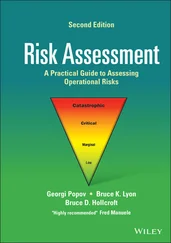Another aspect of cost–benefit assessment is the use of discounting of costs and benefits. In financial calculations, this is common to do and implies that future costs and benefits have a lower value than costs and benefits that we get today. In cost–benefit assessment, this is used sometimes, but not always. There are arguments both for and against using this approach, but perhaps the foremost argument can be tied to the occurrence of accidents now versus in the future. If we have a hypothetical situation, where we know that an accident will occur, but we can choose whether it will occur one year from now or 10 years from now, everyone would undoubtedly choose the latter option. In this respect, we can say that future accidents have a lower “cost” than accidents today and that future risk therefore should be discounted.
To summarize, the ALARP principle states that money must be spent to reduce risk until it is reasonably low and must continue to be spent for as long as the cost of doing so is not “grossly disproportionate” and the risk is not negligible. If a “tolerable” level of risk can be reduced further at a reasonable cost and with little effort, it should be. At the same time, the ALARP principle recognizes that not all risk can be eliminated. Because it may not be practicable to take further action to reduce the risk or to identify the accidents that pose the risk, there will always be some residual risk of accidents.
In the United Kingdom Health and Safety at Work Act and in other regulations, the term SFAIRP is often used instead of ALARP . The two concepts are similar and can usually be interchanged. SFAIRP is an acronym for “so far as is reasonably practicable.”
5.3.2 The ALARA Principle
ALARA is an acronym for “as low as reasonably achievable,” which is the risk acceptability framework in the Netherlands. The ALARA principle is conceptually similar to ALARP, but does not include any region of broad acceptability. Until 1993, the region of negligible risk was part of the Dutch policy. Subsequently, it has been abandoned on the grounds that all risk should be reduced as long as it is reasonable (Bottelberghs 2000). ALARA has gained a somewhat different interpretation in practice. According to Ale (2005), it is common practice in the Netherlands to focus on complying with the upper limit rather than evaluating the reasonable practicality of further action. The unacceptable region in ALARA is, on the other hand, generally stricter than the one in ALARP, and the risk levels usually end up in the same range.
5.3.3 The GAMAB Principle
GAMAB is an acronym of the French expression globalement au moins aussi bon , which means “globally at least as good.” The principle assumes that an acceptable solution already exists and that any new development should be at least as good as the existing solutions. The expression globalement (in total) is important here because it provides room for trade‐offs. An individual aspect may therefore be worsened if it is overcompensated by an improvement elsewhere.
The GAMAB principle has been used in decision‐making related to transportation systems in France, where new systems are required to offer a total risk level that is globally as low as that of any existing equivalent system. The principle is included in the railway RAMS standard (EN 50126 1999). A recent variant of GAMAB is GAME, which rephrases the requirement to at least equivalent .
GAMAB is a technology‐based criterion, which means that it uses existing technology as the point of reference. By applying this principle, the decision‐maker is exempted from the task of formulating a risk acceptance criterion because it is already given by the present level of risk (e.g. see Johansen 2010).
Minimum endogenous mortality (MEM) is a German principle that uses the probability of dying of “technological facts” (e.g. sport, work, transport) as a reference level for risk acceptability. The principle requires that new or modified technological systems must not cause a significant increase of the individual risk for any person (Schäbe 2001). MEM is based on the fact that death rates vary with age and the assumption that a portion of each death rate is caused by technological systems (Nordland 2001).
Endogenous mortality means death due to internal or natural causes. In contrast, exogenous mortality is caused by the external influences of accidents. The endogenous mortality rate is the rate of deaths due to internal causes of a given population at a given time. Children between 5 and 15 have the MEM rate, which in Western countries is about 
 , per person on average (EN 50126 1999). This means that, on the average, one in a group of 5000 children will die each year. The MEM principle requires any technological system not to impose a significant increase in risk compared to this level of reference.
, per person on average (EN 50126 1999). This means that, on the average, one in a group of 5000 children will die each year. The MEM principle requires any technological system not to impose a significant increase in risk compared to this level of reference.
According to the railway standard (EN 50126 1999), a “significant increase” is equal to 5% of MEM. This is deduced mathematically from the assumption that people are exposed to roughly 20 types of technological systems. Among these are technologies of transport, energy production, chemical industries, and leisure activities. Assuming that a total technological risk in the size of the MEM is acceptable, the contribution from each system is confined to
(5.3) 
A single technological system thus poses an unacceptable risk if it causes the individual risk to be increased by more than 5% of MEM. It should be emphasized that this criterion concerns the risk to any individual, not only the age group that provides the reference value. Unlike ALARP and GAMAB, MEM offers a universal quantitative risk acceptance criterion that is derived from the MEM rate.
The MEM principle primarily relies on the technology principle as its basis, in that the criterion is related to existing risk levels.
5.3.5 Societal Risk Criteria
In 2001, the UK HSE published the report “Reducing Risks, Protecting People” (HSE 2001), which includes a proposed societal risk criterion which says that for any single industrial installation, “the risk of an accident causing the death of 50 or more people in a single event should be regarded as intolerable if the frequency is estimated to be more than one in five thousand per annum.” This was the first time there had been a widely consulted and published criterion of this type.
5.3.6 The Precautionary Principle
The precautionary principle differs from the other approaches described in this chapter. Common for these approaches is that they are risk‐based , which means that risk management is to rely on the numerical assessment of probabilities and potential harms (Klinke and Renn 2002). The precautionary principle is, in contrast, a precaution‐based strategy for handling uncertain or highly vulnerable situations. The precaution‐based approach does not provide any quantitative criterion to which the assessed risk level can be compared. Risk acceptability is instead a matter of proportionality between the severity of potential consequences and the measures that are taken in precaution.
Читать дальше
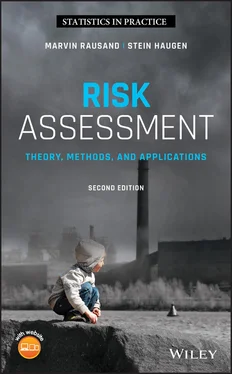

 , per person on average (EN 50126 1999). This means that, on the average, one in a group of 5000 children will die each year. The MEM principle requires any technological system not to impose a significant increase in risk compared to this level of reference.
, per person on average (EN 50126 1999). This means that, on the average, one in a group of 5000 children will die each year. The MEM principle requires any technological system not to impose a significant increase in risk compared to this level of reference.




